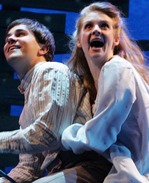HOME PAGE
SITE GUIDE
SEARCH
ADVERTISING AT CURTAINUP
REVIEWS
FEATURES
NEWS
Etcetera and
Short Term Listings
LISTINGS
Broadway
Off-Broadway
NYC Restaurants
BOOKS and CDs
OTHER PLACES
Berkshires
London
California
New Jersey
Philadelphia
Elsewhere
QUOTES
TKTS
PLAYWRIGHTS' ALBUMS
LETTERS TO EDITOR
FILM
LINKS
MISCELLANEOUS
Free Updates
Masthead
Writing for Us
A CurtainUp Los Angeles Review
Mary's Wedding
|
If you don't come home, I'll die of heartbreak. — Mary That's poetry, Mary, not real life.— Charlie |

Brett Ryback and Ashley Bell
(Photo: Michael Lamont) |
Charlie, a Canadian trooper, was thrilled to see King George V of England review the troops. There was a hand-written letter over the mantelpiece of my childhood home, reading "Soldiers of the United States, we salute you" from this same monarch, mimeographed for American troops. The poison gas playwright Stephen Massicotte describes was a lifelong affliction that came home with the soldiers to little towns like mine in Pennsylvania.
The play begins on the eve of Mary's wedding in July, 1920, and takes place during her dream that night. Massicotte brings the sweep of his Canadian homeland into this 90-minute play when he describes how Charlie is afraid of thunder and lighting, foreshadowing the bursting shells of the killing grounds of Europe. Charlie, a farm boy, tends horses lovingly at home and rides them thrillingly through the enemy lines, echoing Tennyson's Â"The Charge of the Light Brigade" which he learned as a schoolboy.
Brett Ryback plays Charlie with unaffected naturalness and a husky physicality that suits the part well. He's ably complemented by Ashley Bell, a fierce but delicate presence as Mary and a strong one as Lt. Gordon Flowerdew, a real-life officer who led the fictional Charlie's squadron to repel the German advance on Moreuil Wood.
Under David Rose's authoritative direction the pair make sense of this dream play in which scenes alternate from the beginning of Charlie and Mary's courtship, to the battlefield, and to scenes in which Mary tells Charlie what's going to happen and he finally tells her the same thing. The playwright handles well the conflict between the wishes of Mary's patrician mother and Mary's attraction to Charlie. Charlie's ordeal on the battlefield begins with the excitement of a cavalry trooper's enthusiasm, encompasses fear and horror, and ends with his dogged attempt to rescue the horses left on the field.
Cricket S. Myers' sound design brings especial brilliance to the battleground and horse riding scenes. David Potts has created an abstract metal set, in which revolving parts serve many purposes, not the least of which is reinforcing the play's locale as a dream.
Both poignant and suspenseful, the play is relevant to this day. Its memories evoke the Great War that was never really over, especially for those whose families were there.
|
Mary's Wedding Playwright: Stephen Massicotte Director: David Rose Cast: Brett Ryback (Charlie), Ashley Bell (Mary) Set Design: David Potts Lighting Design: Jeremy Pivnick Costume Design: A. Jeffrey Schoenberg Sound Design: Cricket S. Myers Running Time: 90 minutes, no intermission Running Dates: October 25-November 23, 2008. Where: The Colony Theatre, 555 N. 3rd Street, Burbank. Reservations: (818)0 558-7000. Reviewed by Laura Hitchcock on October 25. |
|
REVIEW FEEDBACK Highlight one of the responses below and click "copy" or"CTRL+C"
Paste the highlighted text into the subject line (CTRL+ V): Feel free to add detailed comments in the body of the email. |







